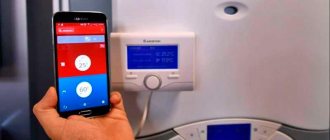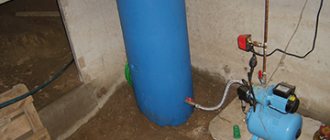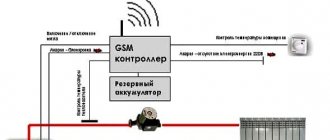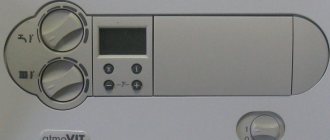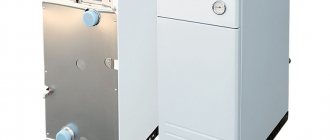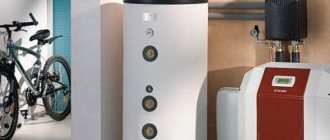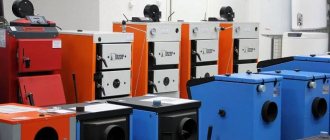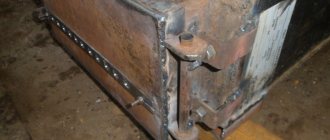Solid fuel boilers of the new type are significantly different from their previous counterparts. They have a modernized control system, which simplifies the operation of the unit, additional functionality, and an increased number of options.
From an ergonomic point of view, setting the required operating parameters is quite beneficial: you perform the action once, and there is no need to periodically adjust it.
The cost of a solid fuel boiler is influenced not only by the availability of high-quality components, but by an improved version of the control unit: the more expensive, the more modern the automation.
The automatic control system is aimed at automating control over the combustion process in a heat generator of this type.
The control unit and fan serve to implement the following tasks:
- maintain the specified temperature of the coolant in the system.
- Provides high efficiency.
- Helps improve efficiency levels.
- They work regardless of fuel quality.
Thanks to equipping the boiler with an automatic system, it became possible to regulate the temperature and increase the burning time of one load by 25-35%.
Principle of operation
Operating principle of a solid fuel boiler
If in older models of solid fuel units, to regulate the air supply, it was necessary to open or close the ash door manually, and monitor the temperature visually using a thermometer, then in new boilers an automatic draft regulator is installed. This device is energy-dependent; its functions include opening and closing the ash pan damper depending on the temperature of the water in the container.
Taking into account the inaccuracy of the settings and the dependence of the operation of the unit on natural draft in the chimney, instead of an ineffective thermostat, a fan was installed to supply the required volume of air to the combustion chamber. And the operation of the fan is ensured by a controller that receives information about the state of the coolant from the sensor.
The controller consists of a screen and a control panel, designed to set the required coolant temperature. Models that do not have such a kit can be equipped with it; the fan is installed on the mounting plate, but you must first disconnect the ash door.
The coolant temperature is adjusted regardless of external conditions.
To maintain the temperature in the room taking into account street conditions, you can install an additional automatic system with an expanded range of capabilities: remote temperature controllers, outdoor air sensor.
Both wired and wireless methods are suitable for connecting them. Thanks to the information received from the sensors, the selected temperature regime in the house is maintained. This is the most rational method.
Safety valve
Modern automatic models have an ignition system, flame control, and continuous fuel supply. For ignition, an electric incandescent element is provided, which turns on after the pellet screw container is fed into the burner.
A stable flame, recorded by a photosensor in the form of a pulse transmitted to the controller, is a signal to turn off the electric ignition. During operation, granules are fed into the auger from a bunker, the volume of which is capable of providing heat to the room for several days, without human intervention.
Solid fuel units with an automatic control system, in addition to the above devices, are also equipped with safety devices, in particular, a safety valve.
It is necessary to discharge water from the boiler tank in case of overheating, to stabilize pressure, and also provides reliable protection of the casing from destruction. The boiler can be equipped with an overheating sensor, which signals if the temperature is exceeded at the initial stage.
So, boilers can be equipped with:
- Traction control sensor.
- Water level sensors in the jacket.
- Fan - smoke exhauster.
- Pressure recorders.
- Circulation pump.
- Fuel and water consumption sensor for domestic hot water.
- Sensors for the level of pellets or coal in the container.
All these devices are interconnected with a controller that performs control and signals emergency situations. The most sophisticated devices have a remote control function, where you can control automation via the Internet and mobile applications.
Other automation devices for solid fuel boilers
In addition to the thermostat, which we met above, the following devices are used to automate solid fuel boilers.
Balancing valve:
As already mentioned when analyzing the first piping scheme, such taps regulate the flow of coolant. There are different types of balancing valves; in the photo there is a valve with a flow meter.
Three-way valve:
Using the black “lid” the desired temperature of the coolant is set. When installing three-way valves, you must be guided by the diagrams, usually printed on their bodies.
Thermal head with remote temperature sensor:
The remote sensor can be placed in a warm floor or on a pipeline. The sensor detects the temperature and gives the command to open or close the valve.
Well, let’s touch on another important topic here...
Features, Pros and Cons
The main functions of the automatic control unit include:
- Dosed supply of combustion air.
- Control over the performance of the heat generator.
- Indirect regulation of thermal power depending on the temperature of the coolant.
- Direct control of power relative to the air temperature in the house or weather conditions.
- Ensuring the operation of the water heating installation in a safe mode.
- Automatic fuel supply.
- Ignition and extinguishing of the furnace of the unit.
Positive aspects of using automation:
- indicator has increased .
- There is no need to constantly monitor the combustion process.
- Economical fuel consumption.
- Maintaining a constant temperature in the heating system.
- during operation of the unit increases
- The interval between scheduled inspections is increasing.
- If a part fails , special sensors send a signal to the control unit, and the heating system automatically turns off (stops its operation).
Flaws:
- High price. The presence of additional options for automation significantly affects the price of the device.
- Considering the volatility of the control unit , there is a need to purchase an uninterruptible power supply, or you can use a mechanical traction regulator.
Types and selection criteria
The automatic control unit is available in both mechanical and electronic versions.
Advantages of a mechanical control system:
- Does not require connection to an electrical outlet.
- Convenience and ease of use.
- Regarding electronic automation , its price is several times lower.
- It is reliable.
- There is no need to call a specialist for installation.
Mechanical automation ensures both the opening and closing of the air duct into the combustion chamber, which affects the rate of combustion of the coolant, its burnout, and the presence of heat in this compartment.
The electronic type of automation is the most efficient, but is a volatile device.
When choosing automation for a heating system, it is recommended to familiarize yourself with its parameters:
- Thermal operating mode.
- The required degree of adjustment of the temperature regime of the coolant.
- Real economic effect.
- Compatibility of the device and the specific boiler model.
Connecting an analogue modulating controller
Another possibility for operating boilers is to use, together with the boiler, not a disconnecting thermostat, but an analogue smooth-action regulator. This allows you to control not only the room temperature, but also adjust the burner power due to feedback. Communication with the gas boiler automation is carried out via a wired or wireless line. It becomes possible to track various parameters that depend on a specific model.
Since this will already be an electronic device, it often immediately becomes possible to control the chronoprofile, that is, heating periods and waiting periods for the boiler are set. You can set several different temperature levels.
Installation and configuration
The installation process of an automatic control system includes:
- Connection of the blower fan. As a rule, the turbine is located on the lowest door of the boiler, where the damper is located. But there are models of units where it is installed on the side wall, or in a special place on the top of the boiler, it all depends on the design features. Everything is simple here: the damper is removed, and a fan is put in its place; four bolts are used for fastening. If there are no holes for mounting, they need to be drilled. For fans with a damper, installation is carried out in such a way that the damper is closed when the fan is off.
- Installation of the controller. First of all, you need to decide on the place where the device will be installed. The main requirement is that it should not heat up. On models without a hob, the automation is mounted on top. If the design of the unit allows, you can install the unit on the side wall. Don't forget about the length of the cables.
- Connecting the temperature sensor. A correctly installed temperature sensor will ensure the normal functioning of the entire control unit. If the model does not have a special place for the sensor (hole parameters: diameter 10 mm, depth 60 mm), then it can be mounted on the output metal pipe. A clamp is used as a fastening material; it can be supplied with the device.
- Connecting connectors. To do this, you need to connect the turbine connector to the control unit connector. Finally, you need to connect the device’s network cable. The automation is ready to perform its functions.
Price and reviews
The cost of an automated system is influenced by the technical indicators and functionality of the device. Thus, the price of the simplest mechanical model varies within 1.5 thousand rubles.
The price range of more progressive options is from 25,000 rubles to 100,000 rubles. The more expensive the model, the higher the ergonomics of the heating system will be, and the resource consumption will be correspondingly lower. Therefore, it is more advisable to give preference to more expensive options.
Reviews:
Nikolai Viktorovich. “The control unit from the Krypton company is one of the best devices today. It is distinguished by the quality of its components; the kit includes a sensor, cords for connecting to the fan and pump, a clamp, and adapters. A reliable device from a Polish manufacturer.”
Fedor. “On the recommendation of a friend, I installed the ATOS automatic, its performance characteristics are excellent.”
Anatoly Yurievich. “The Proton automation surprised me with the presence of additional components in the package (a clamp for attaching the sensor, a stand for the unit, self-tapping screws). The device is efficient, reliable and easy to use. ”
Overview of control unit models
The most popular automatic models are Atos, Comfort Eco, Air and Tech. Having familiarized yourself with their capabilities and properties, the choice is easy to make.
Athos
The Polish-made device is successfully combined with heating boilers with a capacity of 25-50 kW, of various designs and types. The block has a compact size and an intuitive interface. To set all important parameters there is a two-digit dial. The power of the connected pump and fan is up to 130 W. The device allows you to set the coolant temperature in the range of 35-80 ⁰C, and in the room - in the range of 25-50 ⁰C. When the range is exceeded, an alarm is triggered. The average cost of this block is 6,750 rubles.
Its advantages:
- ignition of fuel in any weather conditions;
- increasing the efficiency of the heating boiler while maintaining a stable set temperature.
Air
A functional and affordable option, produced in Ukraine. Allows you to connect a circulation pump with a power of up to 450 W and a fan with a power of up to 220 W. This electronic device is easy to set up and ensures reliable and efficient operation of heating equipment. The user can change the desired temperature level and fan speed at any time. You can purchase such a controller for 3,500 rubles.
Tech
Functional and reliable controller made in Poland. Designed to work with pumps and fans with power up to 200 kW. The case is made of practical materials with additional protection against overheating. It is very convenient to control the entire operation of the boiler thanks to the presence of an extended set of keys and an LCD display. The price of the device is from 6500 to 7200 rubles.
Prices for controllers for solid fuel boilers Tech
controllers for solid fuel boilers Tech
Comfort Eco
Another compact and functional controller from the Polish manufacturer. It is installed directly on the body of the heating device, guaranteeing it protection from overheating and freezing. The power of the connected circulation pump and fan is up to 300 W. The average cost is 7900-8200 rubles.
DIY making
The thermostat, as an automatic device for regulating the operation of the heating system, can be purchased at the electrical goods retail chain.
At the back of this device there is a heat removal plate; it will need to be pressed against the exposed part of the unit. The thermostat has three contacts inside: common, normally open and normally closed. By rotating the adjusting knob, you can change the positions of the contacts.
So you need to set the handle to the minimum mark and connect to the open contacts:
- to the general one .
- We connect one wire from the turbine to the open one
- to the second wire from the turbine .
An automated control system is rightfully considered not only convenient, but also an effective device. With its help, you can significantly simplify the process of operating the heating system.
